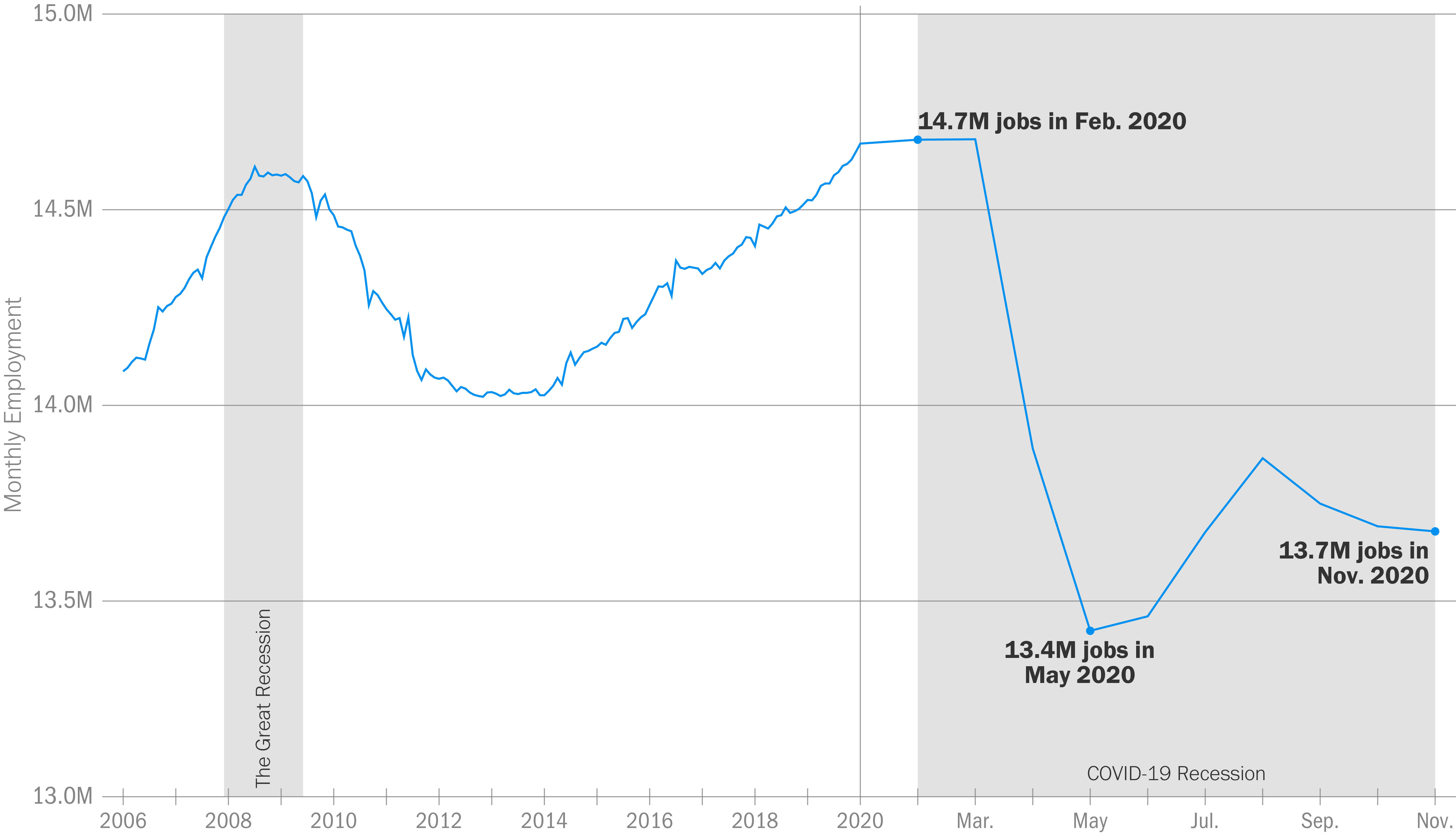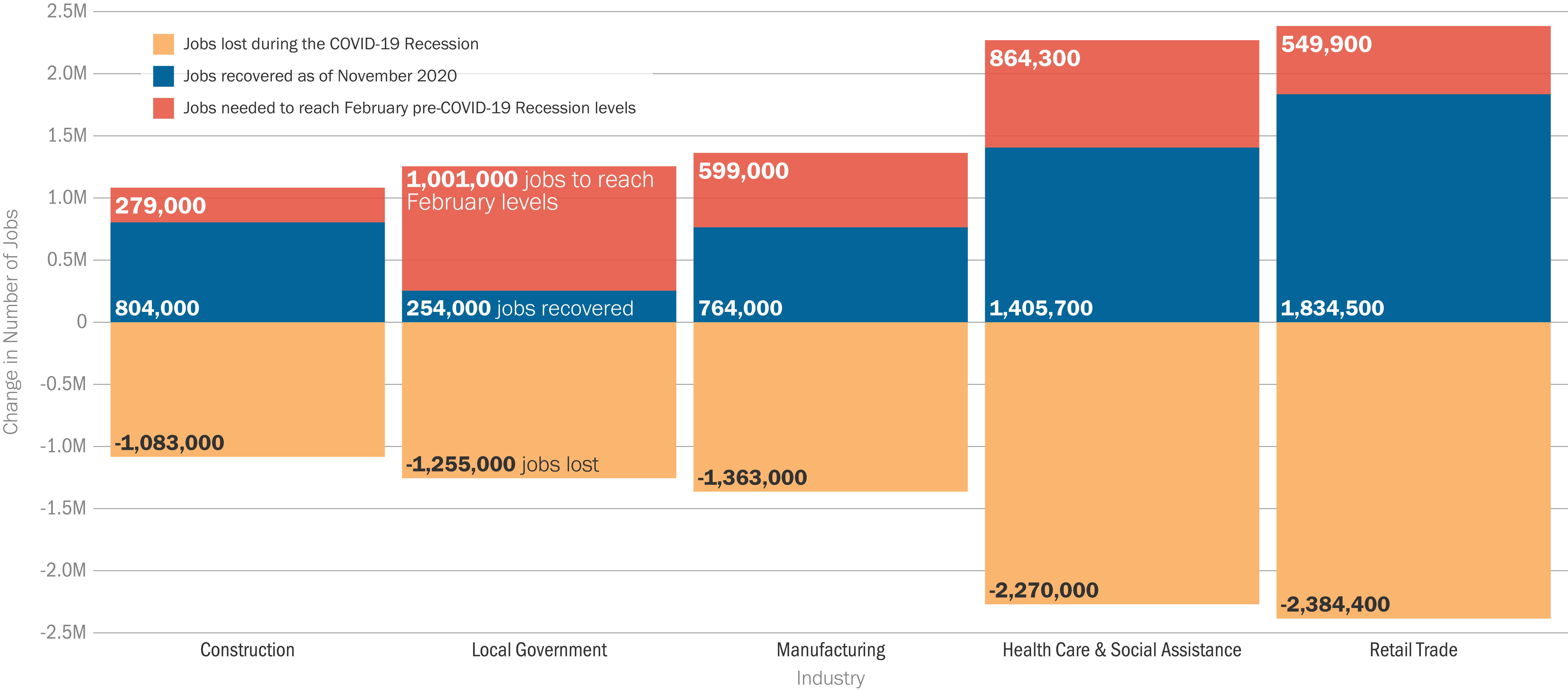Key Takeaways
- Novemberâs job report reflects a stalling economic recovery process: the nation's unemployment rate decreased nominally to 6.7 percent, leaving 10.7 million Americans still unemployed and dropping by a mere 0.2 percentage points from Octoberâs rate (6.9 percent)
- Staggering numbers of workers are leaving the labor force: minimal unemployment rate declines are most likely induced by a contracting labor force participation rate (-0.2 percentage points in November), rather than by job creation, as 400,000 workers left the labor force, discouraged by the lack of employment prospects.
- The local government sector continues to suffer, losing jobs for the fifth of seven months. Local government employment remains over 1 million jobs lower than the sectorâs February level.
- Many sectors which had been slowly recovering in previous months stalled in November, adding very few jobs or even beginning to lose jobs again.
- The pandemic continues to have long-term implications for the workforce: permanent jobs losses remained largely unchanged in November, with 3.7 million workers considered to be permanently laid off. This measure is 2.5 million workers higher than it was in February and represents the long-term impact of COVID-19.
|
The November Employment Situation report from the Bureau of Labor Statistics shows that the national unemployment rate decreased to 6.7 percent in November, leaving 10.7 million Americans still unemployed.. This nominal drop of 0.2 percentage points from October's rate (6.9 percent) is markedly smaller than decreases in previous months. In fact, 0.2 percentage points is the smallest decline in the unemployment rate since the pandemic has begun. This decline in the unemployment rate coincides with increases in initial unemployment insurance claim filings, record-high new cases of COVID-19 and follows on the heels of a national election. November also marks yet another decline in local government jobs, now the fifth month of decline since March despite counties working around-the-clock to protect the health, safety and economic security of local communities they serve.
UNEMPLOYMENT RATE DECREASES A NEGLIGIBLE 0.2 PERCENTAGE POINTS IN NOVEMBER
U.S. unemployment rate, 2007- Nov. 2020
The decrease in November's rate was not due to a large increase in the number of additional jobs but was due rather to a decrease in the labor force participation rate. The labor force participation rate measures the share of workers within the labor force at a given point in time. In November, the participation rate decreased by 0.2 percentage points or the exact amount of decrease in the overall unemployment rate. Nonfarm payroll only increased by a marginal 245,000 jobs in November, much lower than in previous months. This slowdown in improvement could signal stagnation in the short term until the threat of COVID-19 has subsided and normal economic function can resume. Moodyâs Analytics projects the economy will not return to full employment until the end of the year in 2023, or three years from now. This projection relies on the assumption that Congress will pass the necessary additional stimulus to help stabilize the precarious economic situation.
LOCAL GOVERNMENT EMPLOYMENT DECREASES BY ANOTHER 13,000 JOBS IN NOVEMBER
Local Government Employment, 2007 - Nov. 2020

Local government employment decreased again in November, with 13,000 fewer jobs than in October. Employment for local governments now falls more than 1 million jobs short of its February level; this loss comes as local governments work to protect residents from increasing COVID-19 numbers and, in November, finalize national election results. This decrease in local government jobs was once again driven by education-related employment. Continued decreases in this sector occur despite an increasing number of students attending in-person classes in November. Local government education-related jobs decreased by 20,700 jobs compared to October, offset by the 7,200 gains in non-education related jobs for a net decrease in local government employment of 13,000 jobs.
LOCAL GOVERNMENT JOB LOSS AGAIN INDUCED BY DECLINES IN EDUCATION-RELATED EMPLOYMENT
Change in employment by government type, Feb.- Nov. 2020
The federal government also lost jobs in November, with declines ringing in at about 86,000 (mostly census 2020 workers) compared to October. Federal government job declines were driven by non-postal service employment. State governments were the only government entity not to have a net loss of jobs in November. Employment for state governments held steady with zero change from October as state government education employment increased by 4,500 jobs and state-level non-education employment decreased by 4,100 jobs. All in all, government employment dropped by 99,000 jobs in November.
LOCAL GOVERNMENTS NOW OVER 1 MILLION JOBS SHORT OF FEBRUARY LEVELS
Change in employment by selected industries, Feb.- Nov. 2020

In contrast to previous months, recovery stalled for many major industries, with many reporting either minimal gains or even additional losses.
- Employment in transportation and warehousing rose by 145,000 in November. Although the industry has added 472,000 jobs since May, employment in transportation and warehousing is down by 123,000 since February. The majority of the gain in this industry is attributed to gains in couriers and messengers (82,000).
- Professional and business services added 60,000 jobs in November with about half of the gains attributed to gains in temporary help services (+32,000). Despite gains of 1.2 million since April, employment in professional and business services is still down by 1.1 million since February.
- Health care rose by 46,000 in November but is down by 527,000 jobs since February.
- Leisure and hospitality added 31,000 jobs in November yet remained 3.4 million jobs lower than February. Almost two-thirds of the gains occurred in arts, entertainment and recreation (+43,000 jobs).
- Retail trade lost 35,000 jobs over the month, likely due to increased measures to slow the spread of the pandemic and less seasonal hiring in the industry. Employment in retail trade is down by 550,000 since February.
- Manufacturing added a nominal 27,000 jobs over the month. Despite gains in the past 7 months, employment in manufacturing is 599,000 jobs below February levels.
- Construction added only 27,000 jobs in November but is similarly 279,000 jobs lower than in February.
- Other major industries that experienced job gains in November including Financial Activities (+15,000) and Wholesale Trade (+10,000).
PERMANENT JOB LOSSES REMAINS UNCHANGED AT HIGH LEVELS IN NOVEMBER, TEMPORARY LAYOFFS DECREASE AGAIN
Total number of unemployed workers on temporary layoff vs. not on temporary layoff, Feb. - Nov. 2020
Temporary layoffs again decreased in November by 441,000, now at about 2.8 million persons (roughly 2 million persons higher than in February). This downward shift indicates a positive recovery in the economy as more individuals may be returning to work from temporary layoffs. However, permanent job loss is still substantially high. In November, the number of workers considered to be permanently laid off remained unchanged at 3.7 million persons â 2.5 million workers higher than in February. The number of persons permanently laid off contrasts those returning from temporary layoffs, which implies that some of the declines in temporary layoffs can be attributed to the jobs no longer being available. This implication is bolstered by the number of persons who were unemployed long-term, which increased by 385,000 in November â now at 3.9 million persons.
THE ECONOMIC OUTLOOK IS BLEAK
As noted previously, the labor force participation rate declined in November by 0.2 percentage points and is now 1.9 percentage points lower than February. This change indicates that more workers are becoming discouraged with current job market conditions and are thus uninterested in looking for employment. The situation is underscored by the number of persons who are working part-time for economic reasons (but would rather be working full time), which is about 6.7 million people â or 2.3 million higher than in February. These two figures together indicate a bleak outlook on the number of jobs available, an outlook that is forcing individuals to work part-time or to remove themselves from the job market completely.
Both public and private sectors have taken a hit from the coronavirus pandemic and the economic stagnation is widespread across the nation. A recent NACo-led survey of over 1,800 cities, counties and private industries found that 89 percent of respondents think their business, government or organization is worse off now than in January 2020. Seventy-two (72) percent of local government respondents think their financial health has been impacted negatively by COVID-19, and most will face challenges in providing essential services without additional aid. The pandemic is not only a health crisis but an economic crisis too, costing millions of public and private sector jobs. Fifty-nine (59) percent of respondents indicate their business, government or organization has cut the workforce with moderate or significant measures. Business and local governments cannot wait for aid; 91 percent of respondents believe that if Congress does not pass another stimulus, their business, organization or governmentâs condition will worsen.
The November employment situation may seem like another round of good news â the unemployment rate is lowering (albeit marginally), the number of employed persons is rising and most major industries are decreasing the margin between employment levels in February and November. However, the economy is unstable, and the recovery process is stalling. Workers are increasingly discouraged by labor market prospects, local governments that provide essential services continue to experience financial strain and permanent job loss is still remarkably higher than normal levels â all while new cases of the pandemic continue to increase to record high levels which only serve to further exacerbate these economic symptoms. Counties are on the front lines of the fight for public health and safety with county public health departments leading the way in local measures, but we cannot fight the pandemic and the economic situation alone. Counties are in dire need of additional aid in the form of direct, flexible payments to supplement the rising demand on essential services brought on by the pandemic and to sustain the economy which is dangerously at the edge of further degradation.



